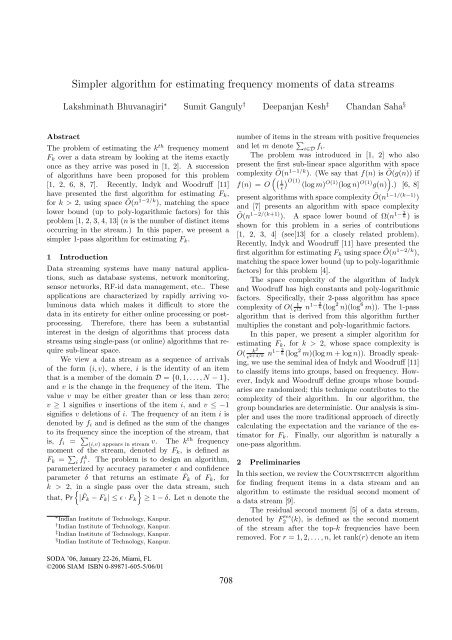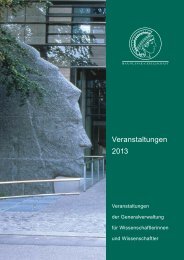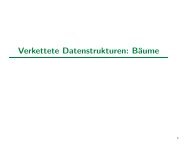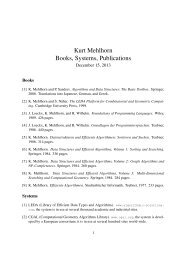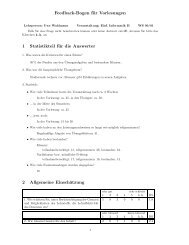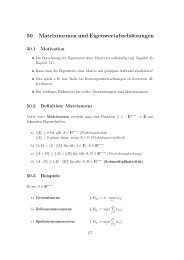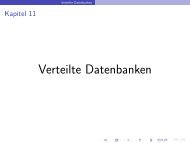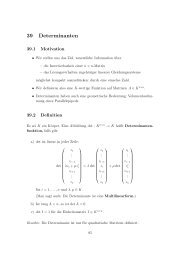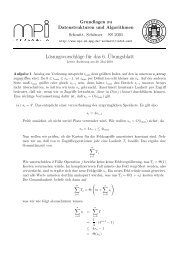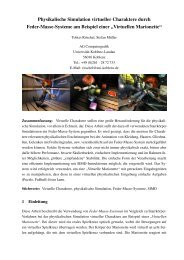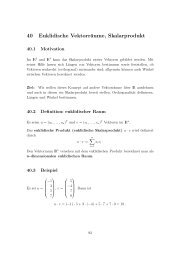Simpler algorithm for estimating frequency moments of data streams
Simpler algorithm for estimating frequency moments of data streams
Simpler algorithm for estimating frequency moments of data streams
You also want an ePaper? Increase the reach of your titles
YUMPU automatically turns print PDFs into web optimized ePapers that Google loves.
<strong>Simpler</strong> <strong>algorithm</strong> <strong>for</strong> <strong>estimating</strong> <strong>frequency</strong> <strong>moments</strong> <strong>of</strong> <strong>data</strong> <strong>streams</strong><br />
Lakshminath Bhuvanagiri ∗ Sumit Ganguly † Deepanjan Kesh ‡ Chandan Saha §<br />
Abstract<br />
The problem <strong>of</strong> <strong>estimating</strong> the k th <strong>frequency</strong> moment<br />
F k over a <strong>data</strong> stream by looking at the items exactly<br />
once as they arrive was posed in [1, 2]. A succession<br />
<strong>of</strong> <strong>algorithm</strong>s have been proposed <strong>for</strong> this problem<br />
[1, 2, 6, 8, 7]. Recently, Indyk and Woodruff [11]<br />
have presented the first <strong>algorithm</strong> <strong>for</strong> <strong>estimating</strong> F k ,<br />
<strong>for</strong> k > 2, using space Õ(n1−2/k ), matching the space<br />
lower bound (up to poly-logarithmic factors) <strong>for</strong> this<br />
problem [1, 2, 3, 4, 13] (n is the number <strong>of</strong> distinct items<br />
occurring in the stream.) In this paper, we present a<br />
simpler 1-pass <strong>algorithm</strong> <strong>for</strong> <strong>estimating</strong> F k .<br />
1 Introduction<br />
Data streaming systems have many natural applications,<br />
such as <strong>data</strong>base systems, network monitoring,<br />
sensor networks, RF-id <strong>data</strong> management, etc.. These<br />
applications are characterized by rapidly arriving voluminous<br />
<strong>data</strong> which makes it difficult to store the<br />
<strong>data</strong> in its entirety <strong>for</strong> either online processing or postprocessing.<br />
There<strong>for</strong>e, there has been a substantial<br />
interest in the design <strong>of</strong> <strong>algorithm</strong>s that process <strong>data</strong><br />
<strong>streams</strong> using single-pass (or online) <strong>algorithm</strong>s that require<br />
sub-linear space.<br />
We view a <strong>data</strong> stream as a sequence <strong>of</strong> arrivals<br />
<strong>of</strong> the <strong>for</strong>m (i, v), where, i is the identity <strong>of</strong> an item<br />
that is a member <strong>of</strong> the domain D = {0, 1, . . . , N − 1},<br />
and v is the change in the <strong>frequency</strong> <strong>of</strong> the item. The<br />
value v may be either greater than or less than zero;<br />
v ≥ 1 signifies v insertions <strong>of</strong> the item i, and v ≤ −1<br />
signifies v deletions <strong>of</strong> i. The <strong>frequency</strong> <strong>of</strong> an item i is<br />
denoted by f i and is defined as the sum <strong>of</strong> the changes<br />
to its <strong>frequency</strong> since the inception <strong>of</strong> the stream, that<br />
is, f i = ∑ (i,v) appears in stream v. The kth <strong>frequency</strong><br />
moment <strong>of</strong> the stream, denoted by F k , is defined as<br />
F k = ∑ i f i k . The problem is to design an <strong>algorithm</strong>,<br />
parameterized by accuracy parameter ɛ and confidence<br />
parameter δ that returns an estimate ˆF k <strong>of</strong> F k , <strong>for</strong><br />
k > 2, in a single pass over the <strong>data</strong> stream, such<br />
that, Pr<br />
{| ˆF<br />
}<br />
k − F k | ≤ ɛ · F k ≥ 1 − δ. Let n denote the<br />
∗ Indian Institute <strong>of</strong> Technology, Kanpur.<br />
† Indian Institute <strong>of</strong> Technology, Kanpur.<br />
‡ Indian Institute <strong>of</strong> Technology, Kanpur.<br />
§ Indian Institute <strong>of</strong> Technology, Kanpur.<br />
number <strong>of</strong> items in the stream with positive frequencies<br />
and let m denote ∑ i∈D f i.<br />
The problem was introduced in [1, 2] who also<br />
present the first sub-linear space <strong>algorithm</strong> with space<br />
complexity( Õ(n1−1/k ). (We say that f(n) is Õ(g(n)) if<br />
(<br />
f(n) = O 1<br />
) )<br />
O(1)<br />
ɛ (log m) O(1) (log n) O(1) g(n) .) [6, 8]<br />
present <strong>algorithm</strong>s with space complexity Õ(n1−1/(k−1) )<br />
and [7] presents an <strong>algorithm</strong> with space complexity<br />
Õ(n 1−2/(k+1) ). A space lower bound <strong>of</strong> Ω(n 1− 2 k ) is<br />
shown <strong>for</strong> this problem in a series <strong>of</strong> contributions<br />
[1, 2, 3, 4] (see[13] <strong>for</strong> a closely related problem).<br />
Recently, Indyk and Woodruff [11] have presented the<br />
first <strong>algorithm</strong> <strong>for</strong> <strong>estimating</strong> F k using space Õ(n1−2/k ),<br />
matching the space lower bound (up to poly-logarithmic<br />
factors) <strong>for</strong> this problem [4].<br />
The space complexity <strong>of</strong> the <strong>algorithm</strong> <strong>of</strong> Indyk<br />
and Woodruff has high constants and poly-logarithmic<br />
factors. Specifically, their 2-pass <strong>algorithm</strong> has space<br />
complexity <strong>of</strong> O( 1<br />
ɛ<br />
n 1− 2 12 k (log 2 n)(log 6 m)). The 1-pass<br />
<strong>algorithm</strong> that is derived from this <strong>algorithm</strong> further<br />
multiplies the constant and poly-logarithmic factors.<br />
In this paper, we present a simpler <strong>algorithm</strong> <strong>for</strong><br />
<strong>estimating</strong> F k , <strong>for</strong> k > 2, whose space complexity is<br />
k<br />
O( 2<br />
n 1− 2 ɛ 2+4/k k (log 2 m)(log m + log n)). Broadly speaking,<br />
we use the seminal idea <strong>of</strong> Indyk and Woodruff [11]<br />
to classify items into groups, based on <strong>frequency</strong>. However,<br />
Indyk and Woodruff define groups whose boundaries<br />
are randomized; this technique contributes to the<br />
complexity <strong>of</strong> their <strong>algorithm</strong>. In our <strong>algorithm</strong>, the<br />
group boundaries are deterministic. Our analysis is simpler<br />
and uses the more traditional approach <strong>of</strong> directly<br />
calculating the expectation and the variance <strong>of</strong> the estimator<br />
<strong>for</strong> F k . Finally, our <strong>algorithm</strong> is naturally a<br />
one-pass <strong>algorithm</strong>.<br />
2 Preliminaries<br />
In this section, we review the Countsketch <strong>algorithm</strong><br />
<strong>for</strong> finding frequent items in a <strong>data</strong> stream and an<br />
<strong>algorithm</strong> to estimate the residual second moment <strong>of</strong><br />
a <strong>data</strong> stream [9].<br />
The residual second moment [5] <strong>of</strong> a <strong>data</strong> stream,<br />
denoted by F res<br />
2 (k), is defined as the second moment<br />
<strong>of</strong> the stream after the top-k frequencies have been<br />
removed. For r = 1, 2, . . . , n, let rank(r) denote an item<br />
SODA ’06, January 22-26, Miami, FL<br />
©2006 SIAM ISBN 0-89871-605-5/06/01<br />
708
whose <strong>frequency</strong> is the r th largest <strong>frequency</strong> (ties are<br />
broken arbitrarily). Then, F res<br />
2 (k) = ∑ r>k f rank(r) 2 .<br />
A sketch [1, 2] is a random integer X = ∑ i f i · x i ,<br />
where, x i ∈ {−1, +1}, <strong>for</strong> i ∈ D and the family <strong>of</strong><br />
variables {x i } i∈D that are either pair-wise or 4-wise<br />
independent. The family <strong>of</strong> random variables {x i } i∈D<br />
is referred to as the sketch basis. 4-wise independent<br />
sketches were used by [1, 2] to present an elegant and<br />
efficient <strong>algorithm</strong> <strong>for</strong> <strong>estimating</strong> the second moment <strong>of</strong><br />
a stream.<br />
Pair-wise independent sketches are used in [5] to<br />
design the Countsketch <strong>algorithm</strong> <strong>for</strong> finding the<br />
top-k frequent items in an insert-only stream. The<br />
<strong>data</strong> structure consists <strong>of</strong> a collection <strong>of</strong> s 3 = O(log m δ )<br />
independent hash tables each consisting <strong>of</strong> A buckets. A<br />
pair-wise independent hash function is associated with<br />
each hash table that maps items randomly to one <strong>of</strong> the<br />
A buckets. The structure can be used to estimate the<br />
<strong>frequency</strong> ˆf i <strong>of</strong> an item i. The estimation guarantees are<br />
stated as a function ∆ <strong>of</strong> the residual second moment<br />
and is summarized below.<br />
( F<br />
res<br />
) 1/2<br />
2 (s)<br />
∆(s, A) = 8<br />
A<br />
Theorem 2.1. ([5]) Let s 3 = O(log m δ<br />
) and let ∆ =<br />
∆( A 8<br />
{| , A). Then, <strong>for</strong> every item i, Pr ˆf<br />
}<br />
i − f i | ≤ ∆ ≥<br />
1 − δ<br />
2·m . The space used is O(A · log m δ · (log(m · N))<br />
bits, and the time taken to process a stream update is<br />
O(log m δ ).<br />
[9] presents an <strong>algorithm</strong> to estimate F res<br />
2 (s) to within<br />
an accuracy <strong>of</strong> (1 ± ɛ) with confidence 1 − δ using space<br />
O( s<br />
ɛ<br />
log(m · N) log m 2 δ<br />
) bits. The <strong>data</strong> structure used is<br />
identical to the Countsketch structure.<br />
3 Estimator <strong>for</strong> F k<br />
In this section, we present our estimator <strong>for</strong> F k .<br />
3.1 Data structure and <strong>algorithm</strong> We use a <strong>data</strong><br />
structure called the hierarchical samples from sketches<br />
structure, denoted by Hsamplesketch, and parameterized<br />
by A = O( 1 n 1− 2 ɛ 4/k k ). The structure is divided<br />
into L + 1 levels, numbered from 0 through L,<br />
where, L = min(⌈log m2<br />
A<br />
⌉, log N). Each level uses a<br />
Countsketch <strong>data</strong> structure [5] with s 1 = O(log(m ·<br />
L · A)) independent hash tables <strong>of</strong> size B buckets<br />
each. A random hash function h : D → D is chosen<br />
from a t-wise independent hash family (t is fixed<br />
later) and is used to define a random mapping <strong>of</strong> items<br />
i ∈ D . . . {1, . . . , L} as follows: level(i) = lsb(h(i)),<br />
where, lsb(a) denotes the least significant bit position<br />
<strong>of</strong> a. Each stream update <strong>of</strong> the <strong>for</strong>m (i, v) is propagated<br />
to the Countsketch structure at level 0 and<br />
to the Countsketch structures at each level l, where,<br />
l ≤ level(i). Thus, item i maps to level 0 with probability<br />
1, to level 1 with probability 1 2<br />
, to level 2 with<br />
probability 1 4 , etc..<br />
Using the <strong>algorithm</strong> <strong>of</strong> [9], we obtain an estimate<br />
ˆF res<br />
2 (A) <strong>for</strong> F res<br />
2 (A) that is accurate to within a factor<br />
<strong>of</strong> 1 ± ɛ<br />
1<br />
4k<br />
with probability at least 1 −<br />
30<br />
. For each level<br />
l, 0 ≤ l ≤ L, we define a threshold S l as follows.<br />
( ) ˆF<br />
S l = 8<br />
res 1<br />
2 (A) 2<br />
A·2 l+1<br />
Thus, S l = S0<br />
, l = 1, 2, . . . , L. Let ˆfi,l denote<br />
2 l/2<br />
the estimated <strong>frequency</strong> <strong>of</strong> item i obtained from the<br />
Countsketch structure at level l, assuming that i<br />
has mapped to level l. The table size parameter B<br />
<strong>of</strong> the Countsketch <strong>algorithm</strong> is chosen such that<br />
if ˆfi,l crosses the threshold S l , then, with probability<br />
1 − 1<br />
30mAL<br />
, the estimate is within a factor <strong>of</strong> (1 ± ɛ)<br />
<strong>of</strong> the true <strong>frequency</strong> f i . If the estimated <strong>frequency</strong> <strong>of</strong><br />
an item i crosses the thresholds S l at multiple levels,<br />
then we disambiguate the estimated <strong>frequency</strong> in favor<br />
<strong>of</strong> the estimate that is returned from the lowest among<br />
such levels l where the estimate crosses the threshold<br />
S l . The estimated <strong>frequency</strong> <strong>of</strong> an item i is denoted<br />
by ˆf i (after possible disambiguation). Items whose<br />
estimated frequencies do not cross the threshold S l at<br />
any level l are said to have undefined estimates. Items<br />
with defined estimates are classified into sample groups<br />
Ĝ l , <strong>for</strong> 0 ≤ l ≤ L, according to the following rule.<br />
Let T 0 = 2 1 4 S 0 and T l = S l−1<br />
2 1/4 , <strong>for</strong> 0 ≤ l ≤ L (i.e.,<br />
T l = (S l−1 S l ) 1/2 ).<br />
Ĝ 0 = { i | ˆf i ≥ T 0 },<br />
Ĝ l = { i | T l ≤ ˆf i < T l−1 and level(i) ≥ l } , 1 ≤ l ≤ L .<br />
The estimate <strong>of</strong> F k is obtained as follows.<br />
(3.1) ˆFk =<br />
L∑ ∑<br />
l=0 i∈Ĝl<br />
ˆf k i<br />
· 2 l<br />
There are L + 1 levels per structure, where, L =<br />
O(log m2<br />
A<br />
). Each level keeps O(log m) hash tables, each<br />
<strong>of</strong> size B = O( k2 A<br />
ɛ<br />
) buckets, where, A = O( 1 n 1− 2 2 ɛ 4/k k ).<br />
Each bucket stores a sketch <strong>of</strong> size log m bits. The total<br />
k<br />
space complexity is there<strong>for</strong>e O( 2<br />
n 1− 1 ɛ 2+4/k k log 2 m) bits.<br />
An additional factor <strong>of</strong> O(log m) is introduced due to<br />
our use <strong>of</strong> Nisan’s pseudo-random generator[12] (see<br />
§ 5).<br />
3.2 Discussion The level function randomly maps<br />
item i to level l with probability<br />
1<br />
2 l . The<br />
709
Countsketch structure at each level is used to retrieve<br />
the top-A items in terms <strong>of</strong> their estimated frequencies<br />
from the set <strong>of</strong> items that map to level l.<br />
The size <strong>of</strong> the hash table B = O( k2<br />
ɛ<br />
A) used by the<br />
2<br />
Countsketch structures is selected in such a way that<br />
the error <strong>of</strong> estimation at level l is at most ɛS l<br />
4k<br />
, that is,<br />
| ˆf i − f i | < ɛS l<br />
4k , with probability at least 1 − 1<br />
30mAL .<br />
Our first part <strong>of</strong> the analysis is essentially devoted to<br />
establishing this fact.<br />
We classify items into groups G 0 through G L based<br />
on their frequencies, by extending the classification used<br />
by the <strong>algorithm</strong>, as follows: G 0 = {i | f i ≥ T 0 } and<br />
G l = {i | T l ≤ f i ≤ T l−1 }. Let i belong to group<br />
G l . We say that an item i is on the left margin <strong>of</strong><br />
G l , provided, T l ≤ f i ≤ T l + ɛ<br />
4k S l. Since, the error<br />
<strong>of</strong> estimation at level l is bounded by ɛS l<br />
4k<br />
, it follows<br />
that the estimated <strong>frequency</strong> <strong>of</strong> such an item may cross<br />
the boundary <strong>of</strong> group G l and may be misclassified to<br />
belong to group G l+1 . The right margin <strong>of</strong> a group<br />
is defined analogously. The remainder <strong>of</strong> the group is<br />
called the middle-region; items that lie in the middle<br />
region <strong>of</strong> a group are correctly classified into the same<br />
group (with probability 1 − 1<br />
30mAL ).<br />
The thresholds T l and S l are constructed such that<br />
if an item i is on the left margin <strong>of</strong> a group G l , then,<br />
its estimate ˆf i,l ′ does not cross the threshold S l ′ <strong>for</strong><br />
accurate estimation at any level l ′ < l (with probability<br />
1<br />
1 −<br />
30mAL ). This can be seen by substituting the<br />
definitions <strong>of</strong> the thresholds, as follows. We assume that<br />
ɛ ≤ 1 and k ≥ 2.<br />
ˆf i,l ′<br />
≤ f i + ɛ<br />
4k S l ′ ≤ (1 + ɛ<br />
4k )T l + ɛ<br />
4k S l ′ < S l ′ .<br />
There<strong>for</strong>e, an item that belongs to the left margin <strong>of</strong><br />
group G l is not “discovered” at any level lower than l.<br />
Further, if i maps to level l, then its estimate crosses<br />
the threshold at level l (with probability 1 − 1<br />
30mAL )<br />
implying that it is “discovered” at this level.<br />
ˆf i,l ≥ f i,l − ɛ<br />
4k S l ≥ T l (1 − ɛ<br />
4k ) > S l since,<br />
ɛ<br />
4k < √ 1 . 2<br />
Thus we can conclude that if an item belongs to the<br />
left margin <strong>of</strong> some group G l and it hashes to level l,<br />
then, its estimate ˆf i is obtained from the sub-structure<br />
at level l. This however, does not mean that such<br />
items are not misclassified. Indeed, due to errors <strong>of</strong><br />
estimation, items that lie in the left margin <strong>of</strong> a group<br />
G l may be classified into group Ĝl or in the group Ĝl+1.<br />
However, in either case, its estimate ˆf i is obtained (with<br />
probability 1− 1<br />
30mAL<br />
) from the structure at level l. An<br />
analogous discussion can be carried out <strong>for</strong> right margin<br />
items.<br />
4 Analysis<br />
In this section, we present an analysis <strong>of</strong> the estimator<br />
<strong>for</strong> F k . We show that with probability at least 1 −<br />
1<br />
30mAL<br />
, every item that hashes to level l and whose<br />
true <strong>frequency</strong> exceeds S l is estimated accurately with<br />
an error <strong>of</strong> at most ± ɛS l<br />
4k . We then calculate the<br />
expectation and the variance <strong>of</strong> the estimator.<br />
4.1 Accurate Retrieval <strong>of</strong> frequent items We<br />
first show that the number <strong>of</strong> items that cross the<br />
threshold S l at level l is O(A). Let H l denote the<br />
set <strong>of</strong> items that map to level l and whose estimated<br />
frequencies cross the threshold S l . Assume that ɛ ≤ 1.<br />
Lemma 4.1. |H 0 | ≤ 5A 4<br />
and |H l | ≤ A, <strong>for</strong> 1 ≤ l ≤ L,<br />
with combined probability at least 1 − 1<br />
30 .<br />
ɛ<br />
Pro<strong>of</strong>. Since, the estimation error at level l is<br />
4k S l,<br />
each item that maps to level l and whose estimated<br />
<strong>frequency</strong> crosses the threshold T l has true <strong>frequency</strong><br />
at least U<br />
l<br />
′ = T l − ɛ<br />
4k S l = 8 ( ) ( )<br />
2 1/4 − ɛ ˆF res<br />
2 (A) 1/2.<br />
4k A·2 l+1<br />
By an application <strong>of</strong> the residual second moment <strong>algorithm</strong>,<br />
ˆFres 2 (A) ≥ F res<br />
2 (A) ( )<br />
1 − ɛ<br />
4k . Thus, U<br />
′<br />
l<br />
≥<br />
) 1/2 (<br />
2 1/4 − ɛ<br />
4k<br />
) ( F res<br />
2 (A)<br />
A·2 l+1 ) 1/2.<br />
There<strong>for</strong>e, the<br />
8 ( 1 − ɛ<br />
4k<br />
number <strong>of</strong> items in f with true <strong>frequency</strong> exceeding U<br />
l<br />
′<br />
is at most n ′ l = A + 2 l+1 A<br />
8·(1− ɛ<br />
4k ) 1/2 (2 1/4 − ɛ<br />
4k ) ≤ A + 2l−2 A,<br />
since, ɛ ≤ 1. There<strong>for</strong>e, |H 0 | ≤ 5A 4<br />
and E[ |H l | ] ≤ n′ l<br />
≤<br />
2 l<br />
A<br />
+ A 2 l 4 . By Chern<strong>of</strong>f’s bounds, it follows that |H l| ≤ A,<br />
<strong>for</strong> l ≥ 1.<br />
Lemma 4.2.<br />
( F<br />
F2 res<br />
res<br />
2 (2 l−1 )<br />
s)<br />
(l, s) ≤ max<br />
2 l−1 , O(log(mAL)<br />
Pro<strong>of</strong>. Let s = Ω(log m). Consider the top-2 l−1 s items.<br />
The expected number <strong>of</strong> these items that map to level l<br />
is 2l−1 s<br />
= s 2 l 2<br />
. By Chern<strong>of</strong>f’s bounds, the actual number<br />
<strong>of</strong> these items that map to level l is at most 3s<br />
4 (since,<br />
s = O(log m)), with probability 1 − 1<br />
30mAL . There<strong>for</strong>e,<br />
the removal <strong>of</strong> the top-s frequencies from those items<br />
that map to level l removes all the items that are in the<br />
top-2 l−1 s ranks. There<strong>for</strong>e, E [ F2 res (l, s) ] ≤ Fres<br />
,<br />
2 l<br />
since, each item is mapped to level l with probability<br />
2 l 1<br />
, with probability 1 − log<br />
30mAL<br />
. Using Hoeffding’s<br />
bounds, F2 res (l, s) ≤ max(2E [ F2 res (l, s) ] , O(log(mAL)).<br />
.<br />
2 (2 l−2 s)<br />
The above inference can also be obtained using generalizations<br />
<strong>of</strong> Chern<strong>of</strong>f-Hoeffding bounds [14], by assuming<br />
that h is O(log L)-wise independent. However, we later<br />
710
use Nisan’s generator to “simulate” full independence<br />
using fewer random bits.<br />
We can now show that the Countsketch structure<br />
at each level can be given sufficient space so that all<br />
items <strong>of</strong> H l can be retrieved with error at most ɛ·S l<br />
4k<br />
(with<br />
probability 1 − 1<br />
30mAL<br />
). By Theorem 2.1, this is possible,<br />
provided, 8 ·<br />
B 1/2<br />
( ) F<br />
res<br />
2 (l, 8 )<br />
B ≤<br />
ɛS l<br />
4k and |H l| ≤ B 8 .<br />
By Lemmas 4.1 and 4.2, this is implied by B ≥ 16k2 A<br />
ɛ<br />
. 2<br />
4.2 Expectation and Variance For i ∈ D and<br />
0 ≤ l ≤ L, let x i,l denote an indicator random<br />
variable, that is 1 if i is classified into group Ĝl and<br />
i hashes to level l. In the following, we assume that<br />
the Countsketch <strong>algorithm</strong> at level l makes two-sided<br />
errors <strong>of</strong> magnitude at most ɛS l<br />
4k<br />
with probability 1; the<br />
error probabilities will be added later using the union<br />
bound.<br />
Lemma 4.3. Assume that the hash function mapping<br />
the items to levels is fully independent. Let i be an<br />
item that lies on the left margin <strong>of</strong> the group G l . Then,<br />
E [ ]<br />
2 l x i,l + 2 l+1 x i,l+1 = 1.<br />
Pro<strong>of</strong>. From the above discussion, we note that since<br />
f i belongs to the left margin <strong>of</strong> group G l , item i is<br />
discovered as a candidate frequent item (i.e., ˆfi ≥ S l )<br />
only at level l and not earlier. Given that i maps to<br />
level l, let p be the probability that i is classified into<br />
Ĝ l . Since, the disambiguation <strong>of</strong> multiple estimates is<br />
done in favor <strong>of</strong> the estimate obtained from the lowest<br />
level, there<strong>for</strong>e, p remains the probability (assuming<br />
fully independent hash function) that i is classified into<br />
Ĝ l , irrespective <strong>of</strong> whether i maps to level l + 1 or not.<br />
The probability that i maps to both levels l and l + 1 is<br />
1<br />
and the probability that i maps to only level l is also<br />
2 l+1 1<br />
. There<strong>for</strong>e, Pr {x<br />
2 l+1 i,l = 1}·2 l +Pr {x i,l+1 = 1}·2 l+1 =<br />
( p<br />
+ p )<br />
2 l+1 2 · 2 l + 1−p · 2 l+1 = 1.<br />
l+1 2 l+1<br />
An analogous property holds <strong>for</strong> items that lie on the<br />
right margin <strong>of</strong> a group. Items that lie in the middle region<br />
<strong>of</strong> group G l are never misclassified (with probability<br />
at least 1− 1<br />
30mAL ), and there<strong>for</strong>e, Pr {x i,l = 1} = 1 ,<br />
2 l<br />
and Pr {x i,l ′ = 1} = 0, <strong>for</strong> l ′ ≠ l. It follows that<br />
E [ ∑<br />
L x i,r · 2 r] = 1,<br />
r=0<br />
<strong>for</strong> i ∈ stream.<br />
The estimator <strong>for</strong> F k can be rewritten as follows:<br />
ˆF k = ∑ i∈D<br />
ˆf k i · x i,l · 2 l .<br />
Let ˜F k denote the following expression:<br />
˜F k = ∑ i∈D<br />
f k i x i,l 2 l .<br />
For each item i that is included in any one <strong>of</strong> the groups,<br />
| ˆf i − f i | ≤ ɛ<br />
4k f i (with probability 1 − 1<br />
30mAL<br />
), which<br />
implies that | ˆf i<br />
k − f i k| ≤ ɛ 2 f i. There<strong>for</strong>e,<br />
(4.2) | ˆF k − ˜F k | ≤ ∑ i∈D<br />
≤ ∑ i∈D<br />
| ˆf k i − f k i |x i,l 2 l<br />
fi k x i,l 2 l = ɛF k<br />
1<br />
, with prob. 1 −<br />
2 20<br />
1<br />
The total error probability is at most<br />
20<br />
, since, by<br />
Lemma 4.1, there are at most 5A 4<br />
frequent items discovered<br />
at each level. Adding the error probability <strong>of</strong><br />
1<br />
30mAL<br />
<strong>for</strong> each <strong>of</strong> these items <strong>for</strong> each <strong>of</strong> L + 1 levels<br />
gives the stated probability.<br />
Lemma 4.4. E [ ˜Fk<br />
]<br />
= Fk .<br />
Pro<strong>of</strong>. By Lemma 4.3, it follows that<br />
E [ ˜Fk<br />
]<br />
= E<br />
[∑<br />
= ∑ i∈D<br />
i∈D l=0<br />
f k i<br />
L∑<br />
fi k x i,l · 2 l]<br />
E [ ∑<br />
L x i,l · 2 l]<br />
l=0<br />
= ∑ i∈D<br />
f k i = F k .<br />
We now consider the calculation <strong>for</strong> Var [ ] ˜Fk . Let Fr (G l )<br />
be the r th <strong>frequency</strong> moment <strong>of</strong> the items in the group<br />
G l , that is, F r (G l ) = ∑ i∈G l<br />
fi r. Let lmargin(G l) denote<br />
the left margin <strong>of</strong> the group G l , that is, lmargin(G l ) =<br />
{i | T l ≤ f i ≤ T l + ɛ<br />
4k S l}.<br />
Lemma 4.5. Var [ ] ˜Fk<br />
∑ L<br />
l=1 F 2k(G l )2 l+1 .<br />
Pro<strong>of</strong>.<br />
Var [ ˜Fk<br />
]<br />
= E<br />
[<br />
( ˜Fk ) 2] − (E [ ˜Fk<br />
]<br />
)<br />
2<br />
= E [( ∑<br />
L ∑<br />
= E [ ∑<br />
=<br />
l=0 i∈D<br />
i∈D<br />
+ ∑ i≠j<br />
L∑ ∑<br />
l=0<br />
f 2k<br />
i (<br />
fi<br />
2k<br />
i∈G l<br />
+ ∑ i≠j<br />
f k i<br />
≤ (F k (lmargin(G 0 ))) 2 +<br />
· x i,l · 2 l ) 2]<br />
− F<br />
2<br />
k<br />
L∑<br />
x i,l · 2 l ) 2<br />
l=0<br />
L∑<br />
L∑<br />
fi k fj k ( x i,r 2 r ) · ( x i,s 2 s ) ] − Fk<br />
2<br />
r=0<br />
s=0<br />
L∑<br />
Pr {x i,r = 1} 2 2r<br />
r=0<br />
fi k fj k E [ L∑<br />
L∑<br />
( x i,r 2 r ) · ( x i,s 2 s ) ] − Fk<br />
2<br />
r=0<br />
s=0<br />
711
y linearity <strong>of</strong> expectation, and, since x i,l = 1 <strong>for</strong> at Lemma 4.6. If ɛ ≤ 1 and A ≥ 23+ k<br />
8 (n 1− 2<br />
most<br />
∑<br />
one level l. For an item i, we now calculate<br />
L<br />
l=0 Pr {x i,l = 1} 2 2l and <strong>for</strong> i ≠ j, E [ ɛ 4/k<br />
k ), then,<br />
( ∑ L<br />
r=0 x i,r2 r Var [ ] ˜Fk ≤<br />
ɛ 2<br />
) ·<br />
( ∑ L<br />
s=0 x i,s2 s ) ] 32 F k 2.<br />
.<br />
( )<br />
F<br />
Consider a calculation similar to that <strong>of</strong> Lemma 4.3.<br />
Pro<strong>of</strong>.<br />
res<br />
k (A)<br />
n−A<br />
≥ F<br />
res k/2.<br />
2 (A)<br />
n−A There<strong>for</strong>e, (F<br />
res<br />
2 (A)) k ≤<br />
If i belongs to the middle region <strong>of</strong> some group G l , then (n − A) k−2 (F res<br />
k (A)) 2 < n k−2 (F res<br />
k (A)) 2 .<br />
i is correctly classified into group l. Thus,<br />
L∑<br />
L∑<br />
F 2k (G l )2 l+1<br />
Pr {x i,r = 1} 2 2r = Pr {x i,l = 1} 2 2l = 22l<br />
2 l = 2 l . l=1<br />
r=0<br />
L∑<br />
≤ T<br />
Now suppose that i lies on the left margin <strong>of</strong> a group<br />
l−1F k<br />
k (G l )2 l+1 , { by defn. <strong>of</strong> group G l }<br />
l=1<br />
G l and let p be the probability that i is classified into<br />
( ) k/2<br />
group G l given that i maps to level l. Then,<br />
L∑ ˆFres<br />
≤ 8 k 2 (A)<br />
A · 2<br />
L∑<br />
l 2 l+1 , { by defn. <strong>of</strong> T l−1 }<br />
l=1<br />
Pr {x i,r = 1} 2 2r<br />
(<br />
r=0<br />
≤ 2 · 8 k 1 + ɛ ) k/2 ∑<br />
L (F res<br />
2 (A)) k/2 2 l<br />
= Pr {x i,l = 1} 2 2l + Pr {x i,l+1 = 1} 2 2l+2<br />
4k<br />
A k/2 2 F k(G kl/2 l )<br />
l=1<br />
= p · res<br />
22l (1 − p) · 22l+2<br />
{ using ˆF 2 A ≤ (1 + ɛ<br />
2 l + 4k )Fres 2 (A)}<br />
2 l+1<br />
= p · 2 l + (1 − p) · 2 l+1<br />
< 2 · 8 k (1 + ɛ 2 ) ∑<br />
L n k−2<br />
1<br />
A k Fres k (A)F k (G l )<br />
2 l(k/2−1)<br />
≤ 2 l+1<br />
l=1<br />
{ using (F res<br />
2 (A)) k < n k−2 (F res<br />
k (A)) 2 }<br />
assuming that the hash function is fully independent.<br />
L∑<br />
An analogous argument can be made <strong>for</strong> items that = ɛ2<br />
F k (G l )<br />
belong to the right margin <strong>of</strong> groups. We there<strong>for</strong>e have 64 Fres k (A)<br />
2 l(k/2−1)<br />
l=1<br />
the following.<br />
L∑<br />
⎧<br />
≤ ɛ2<br />
E [ ∑<br />
L ⎪⎨<br />
x i,r 2 2r] ≤ 2 l+1 if i ∈ G l and l ≥ 1<br />
64 Fres k (A) F k (G l ), { since, k ≥ 2 }<br />
l=1<br />
is ≤ 2 if i ∈ lmargin(G 0 )<br />
r=0<br />
⎪⎩<br />
≤ ɛ2<br />
= 1 if i ∈ G 0 − lmargin(G 0 )). 64 Fres k (A)F k ≤ ɛ2<br />
64 F k 2 .<br />
For i ≠ j, by pair-wise independence, E [ ( ∑ L<br />
r=0 x i,r2 r Analogously, it can be shown that<br />
) ·<br />
( ∑ L<br />
s=0 x j,s2 s ) ] = E [∑ L<br />
r=0 x i,r2 r] · E [∑ L<br />
s=0 x j,s2 s] =<br />
1 · 1 = 1. There<strong>for</strong>e, the expression <strong>for</strong> Var [ ] F 2k (lmargin(G 0 )) ≤ (T 0 ) k (1 + ɛ<br />
˜Fk can<br />
2 )F k(lmargin(G 0 ))<br />
be written as follows.<br />
≤ ɛ2<br />
64 F k(lmargin(G 0 ))F res<br />
k (A) ≤ ɛ2<br />
64 F k 2 .<br />
Var [ ] ∑<br />
L ∑<br />
˜Fk ≤ E [ ∑<br />
L x i,r 2 2r] fi<br />
2k + ∑ fi k fj k − Fk<br />
2 By Lemma 4.5, we obtain that<br />
l=0 i∈G l r=0<br />
i≠j<br />
L∑ ∑<br />
= E [ ∑<br />
L x i,r 2 2r] Var [ ] ∑<br />
L<br />
fi<br />
2k<br />
˜Fk ≤ F 2k (G l )2 l+1 + F 2k (lmargin(G 0 ))<br />
− F 2k<br />
l=1<br />
l=0 i∈G l r=0<br />
L∑ ∑<br />
∑<br />
≤ ɛ2<br />
≤ fi 2k 2 l+1 +<br />
2 · fi<br />
2k<br />
64 F k 2 + ɛ2<br />
64 F k 2 = ɛ2<br />
32 F k 2 .<br />
l=1 i∈G l i∈lmargin(G 0)<br />
∑<br />
Theorem 4.1. If ɛ ≤ 1 and A ≥ 23+ k<br />
8 (n 1− 2<br />
+<br />
fi<br />
2k<br />
ɛ 4/k<br />
k ), then,<br />
{<br />
− F ∣∣ ∣ }<br />
2k<br />
Pr ˆFk − F k ≤ ɛF k ≥ 3 4 .<br />
i∈G 0 −lmargin(G 0 )<br />
L∑<br />
≤ (F k (lmargin(G 0 ))) 2 + F 2k (G l )2 l+1 Pro<strong>of</strong>. By Chebychev’s inequality, Pr { [ ]<br />
| ˜F k − F k | ≤<br />
ɛF<br />
l=1<br />
k<br />
} 4Var ˜Fk<br />
2 ≥ 1 − ≥ 7 8<br />
, by Lemma 4.6 and since,<br />
ɛ 2 F 2 k<br />
712
E [ ] ˜Fk = Fk (by Lemma 4.4). Using triangle inequality<br />
and (4.2), | ˆF k −F k | ≤ | ˆF k − ˜F k |+| ˜F k −F k | ≤ ɛF k<br />
2 + ɛF k<br />
2 ,<br />
with probability at least 1 − 1 8 − 1<br />
20 > 3 4 .<br />
5 Reducing Randomness by using PRG<br />
We use a standard technique <strong>of</strong> reducing the randomness<br />
by using a pseudo-random generator (PRG) <strong>of</strong><br />
Nisan [12] along the lines <strong>of</strong> Indyk in [10] and Indyk<br />
and Woodruff in [11].<br />
Notation on PRG [12, 10]. Let M be a finite<br />
state machine that uses S bits and has running time<br />
R. Assume that M uses the random bits in k segments,<br />
each segment consisting <strong>of</strong> kb bits. Let U r be a uni<strong>for</strong>m<br />
distribution over {0, 1} r and <strong>for</strong> a discrete random<br />
variable X, let F[X] denote the probability distribution<br />
<strong>of</strong> X, treated as a vector. Let M(x) denote the state<br />
<strong>of</strong> M after using the random bits in x. The generator<br />
G : {0, 1} u → {0, 1} kb expands a “small” number <strong>of</strong><br />
u bits that are truly random to a sequence <strong>of</strong> kb bits<br />
that “appear” random to M. G is said to be a pseudorandom<br />
generator <strong>for</strong> a class C <strong>of</strong> finite state machines<br />
with parameter ɛ, provided, <strong>for</strong> every M ∈ C<br />
∣<br />
∣F[M x∈U kb(x)] − F[M x∈U m(G(x))] ∣ 1<br />
≤ ɛ<br />
where, |y| 1 denotes the L 1 norm <strong>of</strong> the vector y. Nisan<br />
[12] shows the following property (the version is from<br />
[10]).<br />
Theorem 5.1. ([12]) There exists a PRG G <strong>for</strong><br />
Space(S) and Time(R) with parameter ɛ = 2 −O(S) that<br />
requires O(S) bits such that G expands O(S log R) bits<br />
into O(R) bits.<br />
The PRG G given by the above theorem can be used<br />
to obtain the random bits <strong>for</strong> our <strong>algorithm</strong>. Thus,<br />
k<br />
we require O( 2<br />
n 1− 2 ɛ 2+4/k k log 2 m(log m + log n)) truly<br />
random bits. We summarize the main result <strong>of</strong> the<br />
paper as follows.<br />
Theorem 5.2. There exists an <strong>algorithm</strong> that computes<br />
ˆF k satisfying Pr<br />
{| ˆF<br />
}<br />
k − F k | ≤ ɛF k ≥ 3 4 using<br />
O(<br />
k 2<br />
ɛ 2+4/k · n 1− 2 k · (log 2 m) · (log m + log n)) bits.<br />
References<br />
[1] Noga Alon, Yossi Matias, and Mario Szegedy. “The<br />
Space Complexity <strong>of</strong> Approximating the Frequency<br />
Moments”. In Proceedings <strong>of</strong> the 28th Annual ACM<br />
Symposium on the Theory <strong>of</strong> Computing (STOC),<br />
1996.<br />
[2] Noga Alon, Yossi Matias, and Mario Szegedy. “The<br />
space complexity <strong>of</strong> approximating <strong>frequency</strong> <strong>moments</strong>”.<br />
Journal <strong>of</strong> Computer Systems and Sciences,<br />
58(1):137–147, 1998.<br />
[3] Ziv Bar-Yossef, T.S. Jayram, Ravi Kumar, and<br />
D. Sivakumar. “An in<strong>for</strong>mation statistics approach<br />
to <strong>data</strong> stream and communication complexity”. In<br />
Proceedings <strong>of</strong> the 34th ACM Symposium on Theory <strong>of</strong><br />
Computing (STOC), 2002.<br />
[4] Amit Chakrabarti, Subhash Khot, and Xiaodong Sun.<br />
“Near-Optimal Lower Bounds on the Multi-Party<br />
Communication Complexity <strong>of</strong> Set Disjointness”. In<br />
Proceedings <strong>of</strong> the 18th Annual IEEE Conference on<br />
Computational Complexity, CCC 2003, 2003.<br />
[5] Moses Charikar, Kevin Chen, and Martin Farach-<br />
Colton. “Finding frequent items in <strong>data</strong> <strong>streams</strong>”. In<br />
Proceedings <strong>of</strong> the 29th International Colloquium on<br />
Automata Languages and Programming, 2002.<br />
[6] Don Coppersmith and Ravi Kumar. “An improved<br />
<strong>data</strong> stream <strong>algorithm</strong> <strong>for</strong> <strong>estimating</strong> <strong>frequency</strong> <strong>moments</strong>”.<br />
In Proceedings <strong>of</strong> the Fifteenth ACM SIAM<br />
Symposium on Discrete Algorithms, 2004.<br />
[7] Sumit Ganguly. “A hybrid technique <strong>for</strong> <strong>estimating</strong><br />
<strong>frequency</strong> <strong>moments</strong> over <strong>data</strong> <strong>streams</strong>”. Manuscript,<br />
July, 2004.<br />
[8] Sumit Ganguly. “Estimating Frequency Moments <strong>of</strong><br />
Update Streams using Random Linear Combinations”.<br />
Proceedings <strong>of</strong> the 8th International Workshop on Randomized<br />
Algorithms (RANDOM).<br />
[9] Sumit Ganguly, Deepanjan Kesh, and Chandan Saha.<br />
“Practical Algorithms <strong>for</strong> Tracking Database Join<br />
Sizes”. In Proceedings <strong>of</strong> the International Conference<br />
on Foundations <strong>of</strong> S<strong>of</strong>tware Technology and Theoretical<br />
Computer Science, FSTTCS 2005, (To appear).<br />
[10] Piotr Indyk. “Stable Distributions, Pseudo Random<br />
Generators, Embeddings and Data Stream Computation”.<br />
In Proceedings <strong>of</strong> the 41st Annual IEEE Symposium<br />
on Foundations <strong>of</strong> Computer Science, 2000.<br />
[11] Piotr Indyk and David Woodruff. “Optimal Approximations<br />
<strong>of</strong> the Frequency Moments”. In Proceedings<br />
<strong>of</strong> the 37th ACM Symposium on Theory <strong>of</strong> Computing<br />
(STOC), 2005.<br />
[12] Noam Nisan. “Pseudo-Random Generators <strong>for</strong> Space<br />
Bounded Computation”. In Proceedings <strong>of</strong> the 30th<br />
Annual ACM Symposium on the Theory <strong>of</strong> Computing<br />
(STOC), 1990, 1990.<br />
[13] M. Saks and X. Sun. “Space lower bounds <strong>for</strong> distance<br />
approximation in the <strong>data</strong> stream model”. In<br />
Proceedings <strong>of</strong> the 34th ACM Symposium on Theory <strong>of</strong><br />
Computing (STOC), 2002.<br />
[14] Jeanette Schmidt, Alan Siegel, and Aravind Srinivasan.<br />
“Chern<strong>of</strong>f-Hoeffding Bounds with Applications<br />
<strong>for</strong> Limited Independence”. In Proceedings <strong>of</strong> the<br />
3rd Annual ACM-SIAM Symposium on Discrete Algorithms,<br />
pages 331–340, 1992.<br />
713


